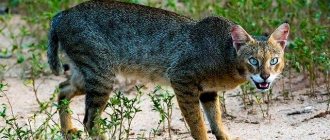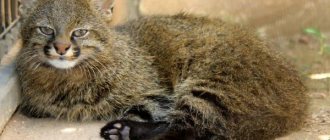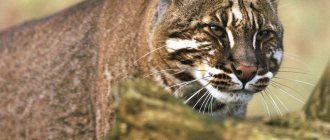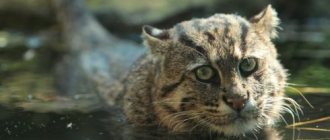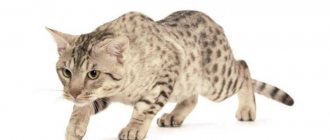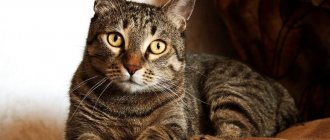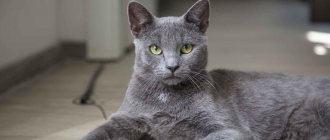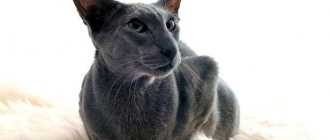The African black-footed cat is a desert animal that, despite its rather small size, is distinguished by its endurance and tough temperament. This predatory and ferocious representative of the cat family prefers to live separately from other animals.
This feline is the smallest and lightest among all its relatives. The black-footed cat is considered the most freedom-loving among the entire cat family. Scientists have discovered only two varieties of this breed. The first lives in the Kalahari Desert, the second has chosen grassy areas for its life.
Black-footed cat in the wild
Black-footed cats are endemic to southern Africa. They live in grassland and semi-desert areas, including arid open savanna, where small rodents and ground-roosting birds are abundant. Small predators settle in empty burrows of porcupines, aardvarks, as well as in devastated termite mounds, which is why they received their second unofficial name - ant tiger. Zoologists distinguish two subspecies of black-footed cats:
- Felis nigripes nigripes - found in Namibia,
- Felis nigripes thomasi (darker in color) - found in Botswana.
Little "tigers" are tireless hunters. In one night they can travel up to 16 km in search of small mammals and make one jump for prey every half hour. More than half of these jumps are successful. Black-footed cats hunt at night in all weather conditions, and their survival abilities are admirable. Not every dryland predator can boast that its menu consists of 54 species of different animals and birds. In addition, cats can go without water for a long time, absorbing as much liquid as possible from live food.
The black-footed cat leads a solitary lifestyle. Males occupy a range of up to 15 km2; it often overlaps with the ranges of females, which occupy about 10 km2. The boundaries of territories are marked by both cats and cats. But if cats mainly use marking odors, that is, they rub against objects, leave feces or urine in visible areas, and scratch with their claws, then cats can spray urine up to 12 times per hour. Cats' calls are very loud compared to animals of similar size. At close range, they use quieter sounds: purring, gurgling, hissing or growling if threatened.
Females reach sexual maturity at 8-12 months. The period of sexual activity lasts literally 1-2 days, and fertilization is possible only within a few hours. After courtship and mating, the couple separates. Pregnancy lasts 60-68 days. Then 1-2 half-naked kittens are born, which are completely covered with hair only by 6 weeks, but at 3 weeks they already begin to leave the den. It is interesting that in case of danger they do not return to the house, but scatter and hide in nearby shelters. They sit quietly until their mother calls. At the age of 7-8 weeks, babies try to hunt prey, which is brought to the mother’s den, and already at 3-4 months they begin to get food on their own. Cats can have up to 2 litters during the year.
The black-footed cat is listed in the International Red Book, as well as in Appendix I CITIES. hunting it is prohibited in South Africa and Botswana. In nature, black-footed cats number just over 13,000 individuals, of which about 10,000 are mature.
Video about African black-footed cats:
https://youtu.be/QVXcKmw3qHI
Habitat
The wild black-footed cat lives only in some southern African countries. They are most often found in the driest areas of the Kalahari Desert, far from people, where large predatory mammals are rarely found.
The main countries where this predator lives are Zimbabwe and South Africa. They can be found less frequently in Namibia and Botswana.
Representatives of this breed live mainly on plains among grass and bushes, where they feel great thanks to their camouflage colors.
Appearance
The black-footed cat is the smallest of all the cats in Africa and is only slightly larger in size than the rusty spotted cat, and therefore takes an honorable second place in the list of the smallest wild cats in the world. The body length of cats is 37-44 cm plus a tail of 16-19 cm. Average weight is 1.9 kg. Cats weigh an average of 1.3 kg, with a maximum of 1.6 kg. Body length usually does not exceed 36 cm plus tail 12.5-17 cm.
The name of these cats should not be misleading. In fact, only the lower part of the legs, which is in contact with the ground, is painted black, not above the metatarsus and wrist. In general, the color is very beautiful: yellow or yellow-brown with dark spots and rosettes along the body. On the upper part of the legs, dark stripes form rings, on the neck there is a “necklace”, and on the muzzle two clear arrows stretch from the eyes back.
Thanks to its coloring, the small cat hides well from enemies and is invisible to its prey. Large eyes are perfectly adapted for hunting at night, and round, mobile ears catch every rustle.
The black-footed cat is quite stocky with large eyes, round ears, a short tail and not too long legs. In addition, black-footed cats have only 6 mammary glands (other cats have light, unpigmented skin, which is not typical for animals with spotted coats.
In addition, black-footed cats have only 6 mammary glands (other cats have light, unpigmented skin, which is not typical for animals with spotted coats.
Boots with legs or how to identify a cat
Despite the fact that it is a predator, its size is small, regardless of gender. Locals call them mini cheetahs or miniature leopards due to their unique coloring and small size. Females can be a little more than 35 cm, but the tail is always half the size of the body. It is light in weight. Maximum one and a half kilos. But this does not mean that the individual is hungry. It’s just that an active lifestyle does not allow you to accumulate the fat that can be found in domesticated cats. Weight that is more than normal will not allow the cat to jump either long or high at the required level for hunting and survival. Since jumps are made not only on the ground, but also from tree to tree.
The speed that an adult develops is equal to that of a lion. The small size and weight only have a positive effect on this ability.
https://youtube.com/watch?v=QVXcKmw3qHI
https://youtube.com/watch?v=QVXcKmw3qHI
Coat
A distinctive feature of the breed, in addition to the black boots on the paws, is considered to be wool. It is relatively short compared to other cat breeds, and is characterized by increased rigidity and a special shine. Molt only before the start of winter. Because there is a complete color change. Or rather, a change in the variegation of colors. In winter, such animals are less bright and colorful. This helps to hide in the desert.
Head and muzzle
Round head shape, wide. A beautiful “face” fascinates a person. The eyes of a cat of this breed are round and expressive. Bright green color. The cat's gaze shows an aggressive attitude towards all living things. Or rather, those who decide to attack a cute creature. Small sandy nose. The ears are relatively small and even, located on the sides. Also sand-colored in the middle. There are no tassels.
Body
Despite their small build, they are muscular. When moving, it resembles a cheetah and leopard. The legs are short and well-muscled. A kind of protection from hot sand. The pads themselves are soft and pleasant to the touch. Color black, covered with pile.
General information
Let's move on to generalizing the characteristics of the African black-footed cat. And it’s worth starting with character: aggressive, active at night. During the day, rest and care for six. Body weight reaches a maximum of 2 kg in adult males, and girls are half a kilo less.
When measuring the height at the withers, it is 20-25 cm. The life cycle is maximum 10 years, but taking into account the fact that it lives in captivity. In the wild, such animals rarely live to be 5-7 years old due to frequent fights between individuals and constant defense of their territory. As practice shows, at home cats are not able to adapt and even after 3-4 generations they show unfriendliness and aggressiveness.
Despite its small build, the cat is distinguished by its muscularity.
Character and habits
The black-footed African cat is extremely unsociable; it hides in a shelter at the slightest rustle, but, driven into a corner, it will desperately defend itself, showing unprecedented courage and tenacity. Females become especially aggressive during the rutting period, pregnancy and raising kittens.
Black-footed cats mostly hunt actively. They do not like to sit in ambush for a long time, and rarely wait for rodents at the hole. They use the darkness of the night and a keen sense of smell, look for traces and get as close to the prey as possible until they can pounce on it. Unlike other cats, they do not like to climb tree branches. The stocky body with a short tail is not adapted for this, but they can vigorously dig through the sand to change the shape of the shelter, making their den more spacious or deeper.
There are legends about the predatory nature of black-footed cats among the Bushman tribes. They say she can kill a giraffe. Of course, this is an exaggeration, which emphasizes her assertiveness and predatory nature. However, she really can try to do the impossible. Eyewitnesses tell how a cat weighing 1.5 kg tracked an ostrich that was sitting in a nest for more than an hour. When the predator was already preparing to jump, the bird stood up and, without even noticing her, disappeared into a cloud of dust.
Reproduction
The cat prefers a solitary lifestyle, looking for a partner only for the duration of mating during the breeding season, which is determined by the female. She marks the territory, and the male finds it using the marks. He does not take any part in raising the offspring, leaving immediately after mating. The gestation period lasts from two to three months, after which no more than two small, pink and hairless kittens are born.
After three weeks, they grow so large that they independently leave the den and explore the territory near it. Wool grows only in the sixth week of life: all this time, kittens feed on mother's milk in the conditions of the mother's nest. One of the characteristic behavioral features is the kitten's desire not to return to the house in times of danger, but to look for a hidden corner and hide in it. The mother finds and protects the baby, teaches him the basics of hunting.
The female is continuously present with the litter only for the first 4 days after birth; then she leaves them for an increasingly longer period, going hunting every night. The cat often changes nests and moves kittens from one place to another. After the babies are a month old, the mother begins to carry half-killed animals into the den and teaches them to attack and kill them. By 7-8 weeks, the cubs obtain food on their own.
Diet
The small predator feeds on small animals, gerbils, shrews, as well as small birds, insects and reptiles. Enjoy eating eggs. In the excitement of the hunt, the cat does not stop even in front of a prey that is twice its own size. Breakfast can be a hare or a black bustard. The thrifty animal does not throw away the uneaten leftovers, puts them in a hole, and then returns to them.
The black-footed cat has very high energy needs. During the night she kills about 14 small animals and eats approximately 250 g of a variety of food, which is 1/6 of her body weight.
Genetics of black color
The black Scottish Fold cat, as well as the straight-eared cat, have a special gene that gives this coat color. This is a gene of the black series, which is designated by the letter B. But since there is always a pair of genes in the set, the black color gene can be presented in the homozygous state BB or in the heterozygous state, for example, Bb (a cat or cat that has a black color, but is a carrier chocolate color gene).
In order for a cat to be like a piece of coal, the B gene is not enough. In addition to it, the cat must also have the color density gene D (in the homozygous form DD or in the heterozygous form - Dd). If a cat has a set of genes not DD or Dd, but dd (d is a diluent gene), then it will force the color pigments inside the hairs to group differently - and the cat will be blue (gray), because gray is the same black, only diluted, or rather, regrouped differently.
There are a number of other genes that help either to form a solid black color, or to create other colors based on the black series gene. But this is the topic of a separate article devoted to genetics. Here we provide only basic knowledge.
Health and life expectancy
Very little is known about the health of black-footed cats in the wild. Scientists were able to detect unusually high levels of creatinine and urea in the blood of healthy animals. In addition, they have higher energy requirements compared to other African wild cats. They are susceptible to the same diseases as domestic cats, so in a zoo they are vaccinated against major infections. Life expectancy in captivity is about 10 years.
The main threats to ant tigers are habitat degradation and the indiscriminate use of poison to control pests, which they accidentally eat. As well as anthropogenic impact on the habitat, the development of agriculture and the expansion of pastures for cattle. A black-footed cat can be killed in a fight with snakes, jackals, and caracals. Sometimes suffers from the teeth of domestic dogs.
Characteristics of the Caracal breed
Caracals stand out from other wild cats with their appearance. A cat that looks like a real desert lynx is the first impression this unusually beautiful animal makes. However, the caracal is not related to the lynx genus and morphologically the breed is more close to the puma.
The paws, thin body and tail are much longer than those of a true lynx, unusually elongated black ears with tassels, as well as a number of genetic differences made it possible to distinguish the caracal into a separate genus. The African serval is also considered close to the caracal family.
To avoid confusion with wild caracals, the breed was given a second name - caracat - to emphasize the domesticity of cats and their focus on humans.
Breed standard
General characteristics of the Caracal breed:
- Body: developed body of a predator – strong, muscular; the length of males can reach 120 cm, females - 110 cm, the average size of a pet is 70-85 cm. Weight: 10-20 kg. Tail length is from 19 to 35 cm. Height at withers is from 30 to 50 cm. Females are smaller than males.
- Coat: Short, soft and dense, honey brown in color, slightly longer and lighter on the inside.
- Head: Dark spots on both sides of the muzzle, black spots above the eyes and a black stripe from the eye to the nose form a uniform tan or brick red color. The nose is dark.
- Eyes: large, yellow-brown.
- Ears: large, vertically positioned, 4-6 cm long, with a black back and dense long tassels made of hard wool.
- Limbs: long, allowing you to easily jump to a height of up to 3 meters. The forelimbs are longer than the hind limbs. The paws have a dense brush of hard hair, which makes it easier to move through the sand in their natural habitat.
- Lifespan: In a home environment, the caracal lives up to 15 years.
Health
Caracals, if properly kept, have good health and good immunity. With proper care and quality nutrition, they practically do not get sick. However, these cats are very curious, and can sometimes chew and swallow inedible objects.
Caracals are vaccinated with regular cat vaccines. Life expectancy at home reaches 15 years.
Character
A well-bred and trained caracal is affectionate and friendly to all household members. He is active, sociable, loves to play. Socialization is one of the most important stages of working with a breed, first for the breeder and then for the owner.
Caracals meow not so often; the main way of communication is hissing and growling in cases of dissatisfaction or uterine rumbling in a complacent mood.
In character, the caracal resembles a cat and a dog at the same time: the gracefulness and curiosity of a cat are mixed with the activity of a puppy. He quickly learns to go for walks on a leash. Educational activities are also a game for him. It is necessary to use various gaming equipment
Pay special attention to games with the ball and suspension
Conservation work and captivity
The black-footed cat has been studied much better than many other small cats. Since 1992, research has been ongoing, which includes monitoring the animals, screening their movements using radio collars, studying the threat and status of the species in various habitats. There are only about 50 black-footed cats in zoos worldwide, about 20 of them in the United States and a few in private hands.
Black-footed cats have difficulty adapting to life in captivity and do not reproduce well. Many zoos have special breeding programs to maintain genetic diversity and avoid inbreeding as much as possible. One of the leading breeding centers for black-footed cats is the zoo in Wuppertal, where African black-footed cats have been successfully bred since 1957. This is where their international stud book is kept.
In America, in 2011, at the Center for the Study of Endangered Species, a black-footed cat gave birth to two kittens as a result of artificial insemination. In 2012, at the same center, embryos were implanted into an ordinary domestic cat, which managed to carry and give birth to one black-footed kitten.
Black-footed cat hybrids
There is experience in successfully crossing black-footed cats with dunes and domestic cats. Such experiments pose a threat to the existence of the species, but this does not stop breeders from trying to breed a domestic cat with a similar color. It is likely that the world of felinology will soon be replenished with another interesting breed.
Those wishing to have a spotted cat with a color like the African Blackfoot can pay attention to the following breeds: Ocicat, California Shining, Bengal, Canaani, Arabian Mau, Egyptian Mau or Serengeti.
The appearance of offspring
There can be no family relationships. Here there is a significant difference from the big brother tiger or leopard. They live alone, and to continue their offspring they meet with females once a year. During the mating season, which begins at the end of August and lasts a little less than a month, males choose their own partner. The male makes marks on his territory so that a stranger does not come to visit.
Next, the storyline takes on two directions. The female will go through all the corners where the boy’s marks are left and will remain on the outskirts waiting for the male. Males expect special attention from girls and allow walks wherever the female wishes. However, she organizes such parties not only during the period when she needs to look for a partner. Cats will never hurt cats and let them through the entire territory.
The entire process of the mating season: from going out in search of a male to copulation takes half a day, and sometimes 8-10 hours. The male, making sure that his “work” is finished, leaves. The female remains to wait and prepare for the birth of her young. Only 2.5 months will pass and she will become a mother. There are no more than two kittens in one litter. In addition to their tiny size, they are also blind and have no hair at all.
Wild cats cannot have any family relationships.
The mother cat is constantly near the babies. The father of the clan does not appear at all. Feelings of paternity or responsibility for offspring do not exist for a cat. Even before the moment of birth, mommy creates something like a den. Where childbirth and feeding take place, kittens grow up and the formation of individuals capable of independently obtaining food takes place. For kittens to become adults and be able to get food on their own, it takes a maximum of 3-4 months.
Since childhood, the instinct of self-preservation has been developed in them. For example, when danger appears, domestic kittens quickly hide behind their mother. The offspring of the African cat behaves completely differently. They quickly hide in different directions, but not in the lair, so as not to show their home to the enemy. Only after the female gives the call to return do the kittens return to the house.
For the first months, approximately 1.5-2 months, the cat is fed exclusively with milk, after which it begins to give meat and other food that it could get early in the morning.
Description
The appearance of the Serval, like that of all predators, is the quintessence of speed, heightened senses and danger. Despite this, the cat adapts well to being kept in captivity.
In nature, there are 14 subspecies of Serval, which differ in the shape and size of spots on the skin, as well as the intensity of color. This diversity is associated with the need for the cat to adapt to the natural environment - shrubs, grass and even the color of the soil.
Servals are recognized by connoisseurs for their predatory coloration and characteristic body structure features:
- Dimensions. The body length of such a cat is in the range of 90-135 cm, while the tail cannot be called long - from 30 to 45 cm. The height of the Serval at the withers is 40-65 cm. The body weight of an adult cat also has a large range - from 8 to 18 kg.
- The cat's body is graceful, medium-sized, muscular and strong. The legs and neck are much longer than the average length of a cat and are distinctive features of the Serval. Nature made sure that it was convenient for these cats to hunt in the thickets of the African savannah. The tail is small and thick relative to the body.
- The head is miniature, compensated by the ears: their size is often comparable to each other. Straight set, rounded. The breed is distinguished by a wide, protruding nose. In profile it is straight, the transition to the forehead is soft. The eyes are wide apart, the upper eyelid has the shape of a boomerang, the lower one is smoother.
- The coat is short, dense and shiny.
- Color. Characterized by dark spots of different sizes and stripes on a light background. In natural subspecies of Servals living in different areas, the color can vary from very dark, almost black, to light. At the same time, the cat’s belly, chest and chin are light in color. Absolutely white individuals with silver spotting are known only in captivity. The outer part of a cat's ears is black with light spots.
Lifestyle
The behavior of representatives of the genus Panthera has common characteristic features. Predators go out hunting at night, prefer to act from ambush, and lead an isolated life. The exception is Lions, who form groups of several individuals and use a driven method of hunting.
Like any cats, Panthers live in a certain territory (up to several tens of sq. km.), They mark the boundaries of their possessions, carefully protecting them from competitors.
Breed characteristics
Standard
Initially, the idea of creating this breed was to bring the appearance of a domestic cat as close as possible to a tiger. The standard takes into account the peculiarities of the breeders' desire for the ideal, for example, the standard establishes the maximum possible contrast between the tiger stripes on the animal's coat and the main color of the coat. Also, the standard often uses the word “preferred”, which provides direction for breeders to work.
- Body: powerful, medium length, muscular, without signs of refinement with dense bones. The chest is wide. The front of the body is weighted, the back is light. The weight of males ranges from 6 to 9 kg, and females 4-6 kg.
- Coat: short, dense, soft, silky, shimmering. Contrasting vertical tiger stripes on the body (modified tabby), muzzle, paws, tail; the fur on the stripes may be slightly longer than the main background, this creates a visual volume of the pattern. The belly and the inside of the limbs, the underarms, the chin, the outer part of the cheeks and the neck are lightened, but painted. The fur on the underbelly is thinner and longer. The facial tiger stripes should be aligned in a circle. The external arrangement of tiger markings should tend to the natural color of the tiger.
- Today, the color “black stripes on a golden background” is recognized (from rich gold to brown, red), however, the color “stripes on a silver background” is being developed.
- Head: wide cheekbones, long muzzle. The corners are rounded. The chin is strong and deep. In profile, the head resembles a hexagon, the corners pass through the control points of the back of the head, forehead, nose and chin. On the ears, temples and cheeks, thick, slightly elongated hair is desirable.
- Eyes: small in size, expressive, located at a slight angle to the ears and outlined with a black edging. It is advisable to lighten the fur around the eyes.
- Nose: the lobe is black, the nose itself is wide - it begins narrowed and widens at the end, rounded in the middle and slightly flattened at the end, long.
- Ears: small, round, set high. The ears should be colored, darker on the outside.
- Limbs: the front legs are strong, of medium length - preferably a little short, which gives the appearance of powerful springy movements. The toes are long. Paw pads are only black.
- Tail: long, powerful, mobile, with a round black tip. Tail set low.
Health
With proper health care, there should be no serious problems. There are no genetic mutations in the breed, so there are no genetic diseases in the breed as such. Lifespan: up to 15 years.
Domestic cats have brought good immunity and gene diversity to the breed, which makes the Toyger strong and often immune to common diseases.
The main diseases of Toygers may be associated with obesity.
Character of Toygers
The little tiger has a bright, friendly character, he is active, but at the same time balanced, and adores his owners.
A cross between the playful, intelligent and affectionate Bengal cat and the curious, obedient domestic cat, the Toyger has a balanced combination of traits from both breeds. Perhaps the best way to describe the Toyger's temperament is to say that it is a combination of the unique personality of the Bengal, with the added bonus of the friendliness and carefree nature of domestic cats.
Smart and curious, they quickly make contact with people and can easily learn all sorts of tricks. They can walk on a leash, play and generally respond well to any training supported by positive reinforcement.
Their sharp mind and active temperament are attributed to their heritage from Bengal cats, however, the main difference between a Bengal and a Toyger, in addition to appearance, is the level of friendliness. Although Bengal cats are loving and affectionate, Toygers take friendliness to a whole other level. They easily become attached to all family members and friends, and also express tenderness towards strangers, which is not typical of most cat breeds.
There is a complete lack of distrust of strangers, they are not cautious, they purr loudly and caress, and are always ready to hug. Increased love for people gives rise to an active demand for attention to oneself at a young age
If a toyger feels the need for a person’s attention, he will meow, walk around and in every possible way seek favor.
However, with age, the character stabilizes, and toygers become calm, a little prim and measured, similar in behavior to wild tigers.
Toygers love children and actively play with them. It is advisable to supervise the play of pets with children under 3 years of age.
Video about the Toyger breed:
https://youtube.com/watch?v=7bOHSLJfk_o
